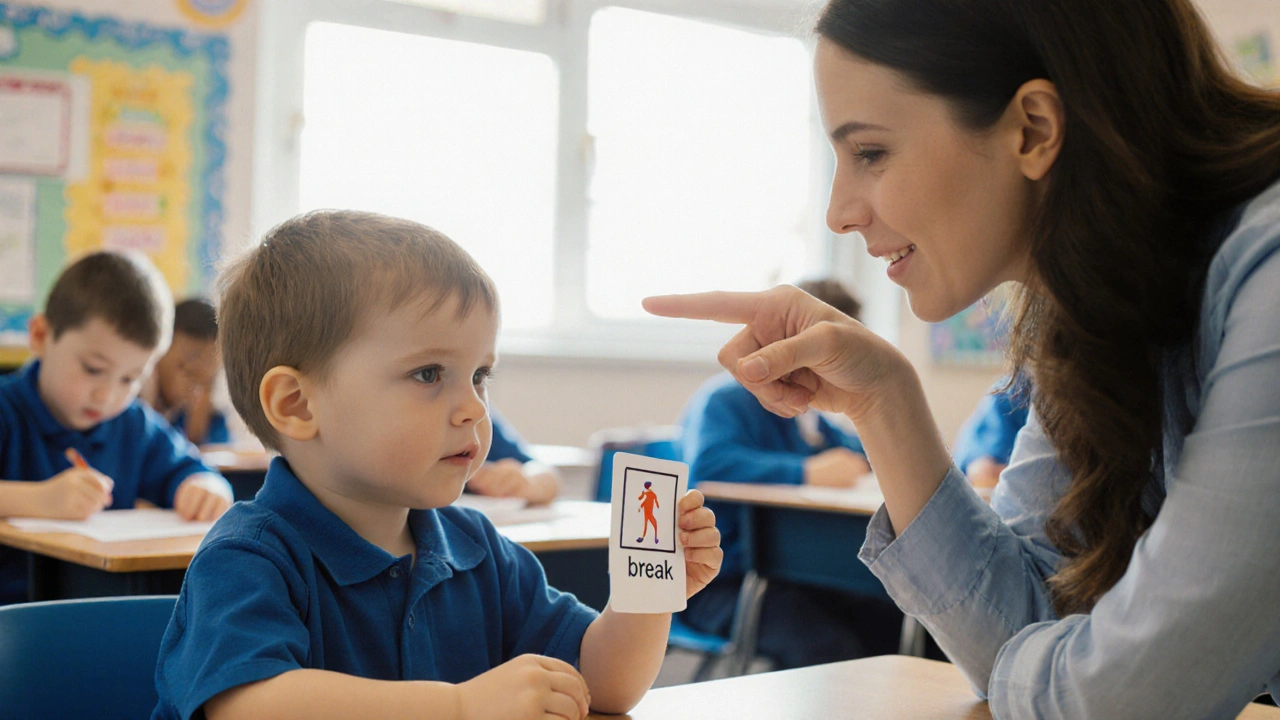Imagine your child melting down in a noisy supermarket but not being able to tell you why. This happens daily for many autistic kids who struggle to express their needs. Teaching self-advocacy isn't about making them "speak perfectly"-it's giving them tools to say self-advocacy works in real life. You don't need special training to start. Simple daily practices can help your child communicate when they're overwhelmed, hungry, or need a break. This guide shows exactly how to build these skills step by step, with examples from real families and strategies backed by autism specialists.
What Self-Advocacy Really Means for Autistic Children
Self-advocacy isn't just talking. For autistic kids, it means recognizing their own needs and communicating them in ways that work for them. This could be tapping a picture card when they need quiet time, using sign language to say "too bright," or even pulling an adult to a quiet corner. The goal isn't fluency-it's reducing frustration and building confidence. Many parents mistake self-advocacy for verbal communication, but kids using AAC devices or gestures are self-advocating too. A 2024 study by the University of Auckland found autistic children who practiced self-advocacy had 40% fewer meltdowns during unmet needs situations.
Self-advocacy is the ability to identify personal needs and communicate them effectively to others, using any method that works for the individual. It includes knowing when to ask for help, setting boundaries, and expressing discomfort before it escalates. Unlike general communication, self-advocacy focuses specifically on the child's right to have their needs met. For example, a child saying "I need a break" during homework is self-advocating, while answering "What's your name?" is basic communication.
Start with Basic Communication Tools
Begin with tools that match your child's current abilities. If your child uses single words, introduce "I need" phrases. For nonverbal kids, try picture exchange cards or a communication app. The key is keeping it simple and consistent. One Wellington parent used a "quiet corner" card her child could hand to teachers when overwhelmed. Within two weeks, the child used it independently during assembly.
Try these starter tools:
- "I need" scripts: Practice phrases like "I need quiet" or "I need help" during calm moments. Role-play at home using their favorite toys.
- Visual cards: Create cards for common needs ("bathroom," "break," "too loud"). Laminate them for school use.
- Body maps: Draw a simple body outline. Have your child point to where they feel discomfort (e.g., stomach for hunger).
Avoid forcing verbal communication if it causes distress. Many autistic children communicate best through gestures or devices. The Ministry of Education's 2025 guidelines emphasize "meeting the child where they are" rather than pushing for verbal output.
Daily Practice Scenarios That Build Skills
Self-advocacy grows through real-life practice. Weave it into routines your child already knows. During breakfast, ask "Do you need more time?" and model the sign for "more." At the park, when they reach for the swing, say "You can say 'I want swing' or show me." Keep it low-pressure-success is them attempting the skill, not perfect execution.
Common practice opportunities:
- Transitions: Before switching activities, ask "Do you need help?" and give a 30-second warning.
- Sensory situations: When entering a loud space, say "I see the lights are bright. Do you need sunglasses?"
- Choice moments: Offer two options ("apple or banana?") and prompt "I choose ____"
One dad in Christchurch practiced at the playground by having his son request "one more turn" on the slide using a picture card. After two weeks, the child started using the card independently during soccer practice. The trick was starting with high-motivation activities where the child naturally wanted to communicate.

Working with Schools and Teachers
Share self-advocacy tools with your child's school. Include visual cards in their IEP or care plan. Request a 5-minute training for teachers on how to respond when your child uses their communication tools. Many schools in New Zealand now include self-advocacy goals in learning plans under the Education and Training Act 2020.
| Step | What to Do | Why It Works |
|---|---|---|
| 1. Share tools | Give teachers laminated cards or AAC device settings | Ensures consistency between home and school |
| 2. Practice responses | Ask teachers to model "I see you need quiet" when using a card | Teaches teachers to reinforce the skill |
| 3. Track progress | Use a shared notebook for successful communication moments | Identifies what strategies work best |
If a teacher says "He should just ask verbally," share how self-advocacy works through their current communication method. Many educators don't realize picture cards or gestures are self-advocacy. The New Zealand Autism Spectrum Disorder Guideline specifically states that communication methods must match the child's abilities.
When to Use AAC Devices or Professional Help
Consider AAC (Augmentative and Alternative Communication) devices if your child struggles with consistent gestures or speech. This includes apps like Proloquo2Go or simple flip books. Don't wait for "perfect" readiness-start when your child shows interest in communication. An AAC device isn't a last resort; it's a tool like glasses for vision problems.
Seek support if:
- Your child has frequent meltdowns with no clear cause
- They withdraw completely in overwhelming situations
- Basic tools aren't sticking after 4-6 weeks of consistent practice
Contact your local Early Intervention Service or a speech-language therapist specializing in autism. In New Zealand, you can get funding for AAC devices through the Ministry of Health's Assistive Technology Scheme. Therapists often use the "Communication Bill of Rights" framework to build self-advocacy skills without pressuring verbal output.

Common Mistakes to Avoid
Many parents accidentally hinder self-advocacy by filling in words too quickly or forcing eye contact. Wait 10 seconds after asking a question-this gives your child time to respond. Never say "Use your words" if they communicate differently. One mom shared how she stopped saying "What's wrong?" during meltdowns and started using "Do you need quiet?" instead. The change reduced meltdown duration by half.
Other pitfalls:
- Overloading with choices: Offering 5 options overwhelms most autistic kids. Stick to 2 choices max.
- Ignoring nonverbal cues: If your child covers ears, don't say "Just be quiet." Try "Too loud? I'll move us."
- Only focusing on school: Practice self-advocacy during fun activities too, like choosing a game.
Remember: self-advocacy isn't about "fixing" communication. It's about respecting your child's way of expressing needs. The goal is for them to feel heard, not to meet neurotypical standards.
Frequently Asked Questions
What if my child refuses to use communication tools?
Start with high-interest situations. If they love swings, only give one push until they request "more" with a card or gesture. Keep sessions under 3 minutes. Many kids resist when tools feel like work-make it part of play. A Christchurch therapist had success by having kids "teach" their stuffed animals to use communication cards first.
How early can I start teaching self-advocacy?
As early as 2 years old. Start with simple cause-and-effect: hand them a toy only when they point or say "go." The New Zealand Ministry of Education's Early Years Framework (2024) shows self-advocacy foundations can begin during preschool years through play-based methods.
My child is nonverbal. Can they still self-advocate?
Absolutely. Self-advocacy includes gestures, pulling someone, using AAC apps, or even leading you to what they need. One 7-year-old in Wellington uses a picture card to request the "quiet room" at school when overwhelmed. That's self-advocacy in action.
How do I handle teachers who don't understand?
Share specific examples: "When Sam hands his 'quiet' card, please take him to the library for 5 minutes. This reduces his meltdowns." If they resist, request an IEP meeting to include self-advocacy goals. The 2025 Education Review Office guidelines require schools to support communication preferences.
What if my child asks for too many breaks?
This is rare. Most kids ask for breaks only when truly overwhelmed. If it happens, use a timer: "You can have 5 minutes quiet now, then we'll try 10 more minutes." The key is honoring the request while building tolerance. A Dunedin study showed that respecting break requests actually increases time on task by 30% over time.



This hit home for me. My daughter used to melt down every time we went to Target until we started using the quiet card. Now she hands it to me without a word. I cried the first time she did it on her own. No words needed.
Self-advocacy isn't about speaking. It's about being understood.
Look, I get the vibe but this is just woke parenting theater. Kids need to toughen up, not get handed picture cards like they're in preschool. Why not just teach them to say 'I need a break' like normal people? This whole AAC thing is just enabling dependency. I've seen kids with full vocabularies who still refuse to speak because they're been coddled with apps. Stop treating autism like a magic disability fairy tale.
What's interesting is how this reframes agency. We don't usually think of communication as a right, but as a skill to be perfected. But what if the goal isn't perfection but presence? What if the child's gesture, their pull, their silent turn away - what if those aren't failures of language, but its most honest forms?
Maybe self-advocacy isn't about teaching them to speak to us, but about learning to listen to them - in the language they already know.
That’s the quiet revolution here.
Simple and effective. I use visual cards with my nephew in India. He points to ‘break’ when music is too loud. No words. Just peace. This works everywhere.
Less theory, more practice.
Let’s be real - this is just corporate neurodiversity compliance dressed up as parenting advice. The Ministry of Education’s ‘guidelines’? That’s bureaucratic theater. The real agenda? Get schools to outsource behavioral management to parents so they don’t have to hire more aides. AAC devices are expensive. Who’s funding them? Who’s auditing outcomes? And why is every example from New Zealand? Coincidence? I think not. This is a stealth funding pipeline disguised as compassion.
Bro this is literally life-changing 😭 I tried the body map with my son and he pointed to his head when the lights were too bright - I had no idea he felt that way. Now we have a ‘glow dim’ card and he uses it before meltdowns. I’m not crying, you’re crying. Also, if you don’t have Proloquo2Go, get it. It’s like Siri but for your soul. 🙏✨ #AutismParentingWin
I used to think my son was just being difficult. Turns out he was just trying to tell me his socks hurt. We started using the ‘too tight’ card. Now he gives it to me before we even leave the house. I wish I’d known this two years ago.
Oh, for god’s sake. Another sanctimonious guide on how to parent your autistic child like they’re a delicate orchid in a museum. Let me guess - you also sing lullabies to their sensory needs and whisper ‘you’re valid’ into their weighted blanket? Please. The real world doesn’t care if your kid needs a ‘quiet corner’ at the supermarket. He’s going to grow up in a world that doesn’t carry laminated cards. Maybe teach him to cope instead of coddle? This is less parenting and more performance art.
I’ve spent the last five years navigating this exact path with my son, and I can tell you - the tools listed here are spot on, but the real magic happens in the consistency. It’s not about buying the app or printing the cards. It’s about showing up every single day, even when you’re exhausted, even when your partner thinks you’re overdoing it, even when the teacher says ‘he’ll grow out of it.’ The breakthrough moment? When he used his ‘I need space’ card during a family dinner and we all stopped talking for five minutes. No one said a word. And for the first time, he smiled. That’s not a strategy. That’s a revolution in quiet.
Good stuff. I’d add one thing: don’t forget to model self-advocacy yourself. Kids notice when you say ‘I need a minute’ or ‘this noise is too much.’ That’s the quietest form of teaching. They learn by watching you claim your own space. It’s not just for them - it’s for all of us.
There’s a critical distinction here that’s often overlooked: self-advocacy is not synonymous with expressive language. It’s the internal recognition of need paired with intentional communication - regardless of modality. The 2024 University of Auckland study referenced is methodologically sound, with a Cohen’s d of 0.82 for reduction in escalation events. However, longitudinal data beyond six months is sparse. I’d recommend pairing these tools with functional communication training (FCT) protocols and tracking via ABC (Antecedent-Behavior-Consequence) logs for optimal generalization across environments.
Oh wow. Another ‘autism is beautiful’ fairy tale from the mommy bloggers. Let me guess - you also think your kid’s stimming is ‘cute’ and that forcing eye contact is ‘ableist’? Newsflash: the world doesn’t care about your child’s ‘communication style.’ They’ll be mocked in middle school, fired in college, and bullied at work because you thought a picture card was enough. This isn’t empowerment - it’s delusion wrapped in glitter. Real self-advocacy means teaching them to speak, not to hand out laminated notes like they’re in a therapy circus. If your kid can’t say ‘I need help,’ you’re failing them.
So we’re just supposed to ignore the fact that most of these tools only work in controlled environments? My kid uses the quiet card at home but freezes at school because the teacher doesn’t ‘get it.’ So what? We’re supposed to just keep printing more cards? This is like giving someone a parachute and then throwing them out of a plane without training them how to pull the cord. I’m tired of being told to ‘just try harder’ while the system does nothing. And yeah, I’m sarcastic. I have to be. Because no one else is listening.